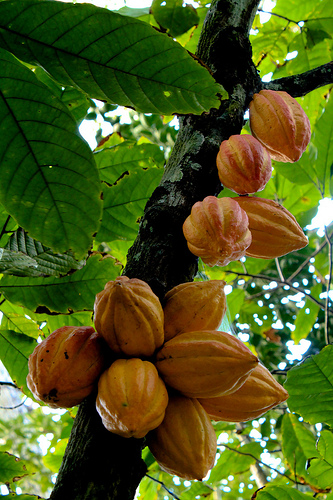Cacao is a crop of great commercial value and has a competitive advantage both in the domestic and international markets. Cacao processed beans are used mainly by manufacturers of chocolates, cocoa powder, soaps, cosmetics, shampoo and other pharmaceutical products.

Despite the bright future of this crop, the domestic production level of cacao has been decreasing, from 7.945 metric tons in 1994 to 7,000 metric tons in 1999. This can be attributed to some long-standing problems such as of lack of superior varieties and inadequacy of technologies on pest management and postharvest handling and processing and the poor farming systems.
In an attempt to address this concern, the University of Southern Mindanao (USM) in Kabacan, North Cotabato tested and used nodal grafting technique to propagate cacao cultivars with superior characteristics (uniform and vigorous growth and free from diseases).
Nodal grafting involves the use of a scion (shoot) that is inserted in the node of mother stock to produce high quality planting materials.
The steps involved in nodal grafting are as follows:
- Construct a nursery shade (mature bamboos for frame and coconut fronds for roof) 7-ft high. The shade should be about 50%.
- Fill black polyethylene bags (5″x7″) with garden soil. Perforate the bags (at least 10 holes) and arrange them in rows (4 bags/row with a 2 ft. distance between rows). Use recommended rootstock varieties such as UIT1, UIT2, and 246A.
- When at least a pair of leaves has emerged from the stock, water and place the rootstocks together in a 12″x16″ white/transparent polyethylene bags. Increase the shade percentage of the nursery to 80%.
- Get a scion of recommended varieties from accredited budwood gardens.
- Cut the stock stem two inches above the node leaving a pair of leaves. Cut the middle of the stem to at least 1/2 inch deep. Cut the scion (with one node) diagonally into 3 inches long. Insert the scion stem in the rootstock. Make sure that stock and scion cambium are in good contact.
- Use a .003 inch polyethylene strip to tighten the connection. Use paper clip or any materials that can hold the scion and stock together until callus are formed.
- Place a stick in the middle of transparent polyethylene bag and tie it.
- At the time the scion has produced new shoots, open the polyethylene bag partially.
- After two weeks, remove the transparent polyethylene bag and arrange the seedlings following step 2.
- Apply fertilizer (urea) to the seedlings
Ideally, grafted seedlings are planted before reaching four months.
—————-
For more information, please contact Dr. Ruben Cabangbang, National Plantation Crops Network Office, University of Southern Mindanao, Kabacan, North Cotabato, Tel.No. (064)248-2323).
By: Mary Charlotte O. Fresco, BAR Digest, July-September 2001 Issue (Vol. 3 No. 3)

